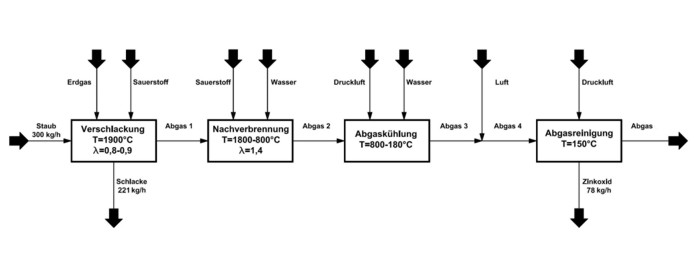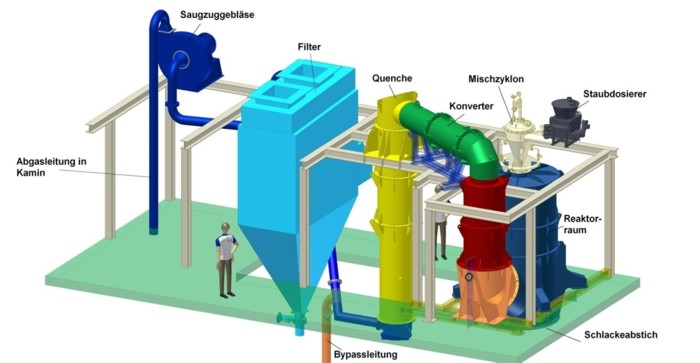Flash Reaktor
Dusts of the iron- and steelmaking industry are loaded with heavy metals like zinc. The zinc load is mainly rooted in the charging of scrap. Due to environmental and economic reasons the recycling of these dusts has to be investigated. The majority of the steel mill dusts (especially EAF–dusts) are processed in the Waelz-Process. Several new technologies have been developed, but many could not stand a comparison with the Waelz-Process.
The Reco-Dust-Process is a new technique for processing steel mill residues which fits perfectly into an integrated steel mill. In the last years a Flash-Reactor pilot plant has been designed built up and set into operation at our chair in cooperation with voestalpine. Main goals are the further development of the pilot plant and a scale-up. Furthermore, it is potentially possible to process all zinc containing materials of a steel mill in the Flash-Reactor.
The Reco-Dust process can be divided into four steps (see Fig. 1). The slagging of the dust under reducing conditions is the first step. The dust is charged into a mixing cyclone where it gets oxygenated. The mixing cyclone feeds the oxygen/dust mixture nearly directly into the reducing flame in the reaction vessel, where at temperatures of up to 1900 °C, the volatile components of the dust are separated into the gas phase. The second process step is the post combustion of the flue gas where the zinc vapour is transferred into its solid oxide phase. For this effect water and oxygen are injected, providing oxidizing conditions. Because of the flue gas temperature of 1800 °C and the post combustion process, water decreases the temperature down to 800 °C at the end of step two.

Figure 1: Process description
To enable flue gas cleaning with a bag filter, the flue gas needs to get cooled from 800°C to 150°C within the third process step. In the last step the dust is separated and discharged discontinuously, while the clean flue gas leaves into the atmosphere.
The process principle has been proven and the quality of the products is very satisfying. The slag is rich in iron and the quality of the zinc oxide is at least comparable to Waelz oxide.
Because of the ability of the Flash-Reactor to melt small amounts of powdery material, there is a wide field of applications. The Flash-Reactor is used as a smelting aggregate for blast furnace slag, which is used for granulation tests a tour chair.

Figure 2: 3D- View of the pilot plant









